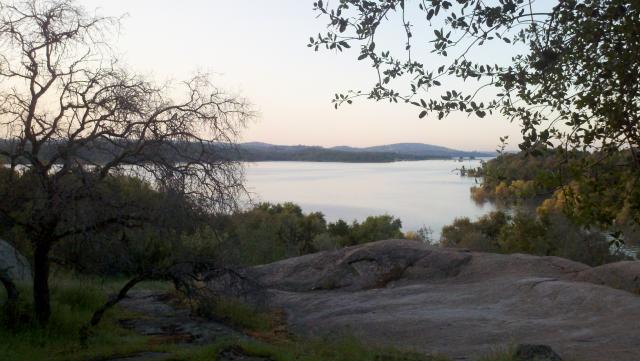The ride started with beautiful views of Folsom Lake.
As endurance riders, I think sometimes we are so focused on conditioning that we forget about *training* the horse. I’m guilty of this myself. As a result, my chargy little Arab has gotten worse and worse at the start of each ride. I normally start at the back of the pack with a buddy horse, but this year I’m attempting to teach him to be a little more independent. So far this season this has involved hauling him solo to rides and attempting to start rides on our own at a sensible pace. Unfortunately Bite’s idea of a sensible pace is somewhere oh, just slightly faster than everyone else. At the last ride, our debate regarding pace included him depositing me into the sand. I felt pretty strongly that I didn’t want to repeat that at American River. So Bite and I have started couples therapy. And our unlikely counselor has been my non-horsey husband, Russell. He suggested that if Bite was going to act like a green horse, I should treat him like one. Genius. Why didn’t I think of that?
The ride was scheduled to start at 5:30. I saddled Bite by 4:45 and spent the next 45 minutes sacking him out, pulling on his crupper, and mounting/dismounting just like I would with a baby horse. I rode him around camp until the hump in his back disappeared and when the ride started, we snuck in behind a rider who was walking out of camp. Magic. No jumping around, no pretending like he’d forgotten how to steer, and no dumping his rider onto the ground. Even if everything had gone downhill from there, I was already completely thrilled with our ride.
I was warned about this ride’s bad reputation with hoofwear. I remember last year hearing about multiple boot and shoe losses on the trail. And given the very technical terrain, I can understand why. The trail includes a little bit of everything: mud, steep climbs, creek crossings, and big rocks to clamber over. I prepared for this by adding Goober Glue (a leftover tube from before the product changed to Sikaflex) to Bite’s Gloves, as well as applying copious amounts of athletic tape and Powerstraps to all four boots.
Around mile 10, we were moving along on a single track trail in a large group of horses. A man behind me commented on how nicely my boots were staying in place despite the challenging trail. I replied that this was thanks to the mass quantities of tape, power straps, etc. I had used. Literally seconds later, I looked down to see Bite’s left front boot clinging desperately to his pastern by the gaiter. Sigh. I quickly dismounted and let everyone pass. I reapplied the boot, this time with even more athletic tape. For the remainder of the ride, all four boots stayed perfectly in place through more mud, creeks, and steep climbs. I heard of two other booted riders who lost a boot at some point during the ride and counted seven lost shoes along the way. This reminded me that whether your horse is booted or shod, we’re all going to have hoofwear challenges along the way. I’m thankful, however, that since my horse is in boots, fixing the problem is as simple as slapping the boot back on, rather than a) hoping he didn’t rip off a chunk of hoof with his shoe and b) hoping someone at the vet check can reapply the shoe.

Resting at 43 miles with our crew/husband/cheerleader, Russell. Photo by Lucy Chaplin Trumbull.
I met another boot user, Diana Hiiesalu Bain, who rides a gorgeous little bay named Ali. He has “hock issues” and she reported that keeping him barefoot/booted has been a huge help for this issue. It’s so cool that boots not only provide hoof protection but can also decrease concussion on our horses joints! Ali looked pretty solid to me and set a very consistent pace down the trail. I had the pleasure of riding most of the last 20 miles with Diana and another fun rider, Maryanne. We ended up finishing together and our horses were absolute freight trains the last 5 miles. The last 4 or 5 miles is on the Tevis trail which meant we got to cross No Hands bridge and pretend like we were finishing Tevis in the daylight. Bite was going to charge into camp with our without me so I just clung on and let him do his thing. He finished looking positively phenomenal and I couldn’t have been more proud of him.

Crossing No Hands Bridge, just a few miles from the finish
The ride starts and finishes in two different locations, so I was thankful to have the Worlds Best Crew, my husband Russell and Lucy Trumbull, who moved the rig and met Bite and I at each vet check. This was most definitely one of the toughest 50’s I’ve done so I appreciated seeing their friendly faces at the vet checks. I’m glad we were prepared ahead of time and able to make little modifications to our boot protocol. These little changes were a big help in keeping our boots on and allowing us to have a successful ride. I loved this ride, and can’t wait to go back!
Renee Robinson





